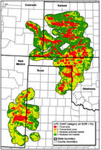Anglers can dish up a great day on the water using information found
in the 2014 Fishing Forecast
You don’t have to be a world-renowned chef to recognize a good meal when you eat one, and now you don’t have to be a Master Angler in order to catch fish like one. The 2014 Fishing Forecast, produced by the Kansas Department of Wildlife, Parks and Tourism (KDWPT), is an instrumental ingredient when creating the perfect day on the water. Simply take a helping of research, combined with a few choice lures, add in some free time, and you just might find yourself with a recipe worth revisiting this fishing season.
Since the 2014 Fishing Forecast uses data gathered from sampling efforts of public waters during annual lake monitoring, anglers can rest assured they are receiving the best possible information on where to fish and what to fish for. In addition to what species of fish can be caught at any given body of water, the forecast also includes tables with Density Ratings, Preferred Ratings, and Lunker Ratings, as well as information on the Biggest Fish sampled, Biologist’s Ratings, and a Three-Year Average of popular species.
The Density Rating is the number of fish that were high-quality size or larger sampled per unit of sampling effort. High-quality size, listed in parentheses at the top of the Density Rating column, is the length of fish considered acceptable to most anglers and is different for each species. The higher the Density Rating, the more high-quality-sized or larger fish per surface acre in the lake. Theoretically, a lake with a Density Rating of 30 has twice as many high-quality-sized fish per acre as a lake with a Density Rating of 15.
The Preferred Rating identifies how many above-average-sized fish a water contains. For example, a lake may have a good density of crappie, but few fish over 10 inches. The Preferred Rating tells an angler where to go to for a chance to catch bigger fish.
The Lunker Rating is similar to the Density Rating, but it tells you the relative density of lunker-sized fish in the lake. A lunker is a certain length of fish considered a trophy by most anglers. It also differs with each species and is listed in parentheses at the top of the Lunker Rating column. For example, most anglers consider a channel catfish longer than 28 inches a lunker. Many lakes may have a lunker rating of 0, but this does not mean there are no big fish in that lake. It just means that no lunker fish were caught during sampling, and they may be less abundant than in lakes with positive Lunker Ratings.
You can use the Density Rating and Lunker Rating together. If you want numbers, go with the highest Density Rating. If you want only big fish, go with the Lunker Rating. Somewhere in the middle might be a better choice. A lake with a respectable rating in all three categories will provide the best overall fishing opportunities.
The Biggest Fish column lists the weight of the largest fish caught during sampling. A heavy fish listed here can give the lunker fishermen confidence that truly big fish are present.
The Biologist’s Rating adds a human touch to the forecast. Each district fisheries biologist reviews the data from annual sampling of their assigned lakes. This review considers environmental conditions that may have affected the sampling. They also consider previous years’ data. A rating of P (poor), F (fair), G (good), or E (excellent) will be in the last column. Sometimes the Density Rating may not agree with the Biologist’s Rating. This will happen occasionally and means the Density Rating may not accurately reflect the biologist’s opinion of the fishery.
The Three-Year Average rating refers to the averaging of the Density Rating over the previous three years of sampling to help show a trend for a particular lake.
Copies of the 2014 Fishing Forecast can be found in the March/April issue of Kansas Wildlife & Parksmagazine, at any KDWPT office or license vendor, or online at ksoutdoors.com by clicking “Fishing/Fishing Forecast.”



